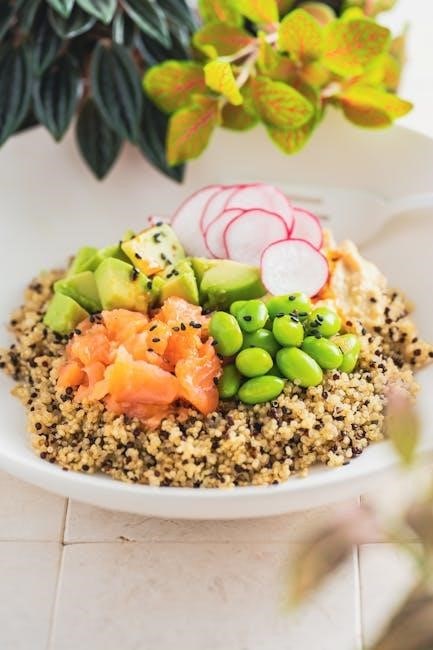Carb cycling involves alternating high-carb and low-carb days to optimize weight loss and muscle retention. A free carb cycling meal plan PDF provides structured guidance, including recipes and tips, to help individuals implement this diet effectively.
1.1 What is Carb Cycling?
Carb cycling is a dietary strategy that involves alternating between high-carbohydrate and low-carbohydrate days to optimize weight loss, muscle retention, and energy levels. This approach allows individuals to manipulate their carbohydrate intake to achieve specific fitness goals, such as shedding fat while maintaining muscle mass. By cycling carbs, the body is kept in a metabolic state that promotes fat burning on low-carb days and replenishes energy stores on high-carb days. This method is popular among athletes and bodybuilders but has also gained traction with individuals seeking a structured yet flexible diet plan. A free carb cycling meal plan PDF can serve as a valuable resource, offering tailored guidance and recipes to help users implement this diet effectively.

1.2 Benefits of Carb Cycling for Weight Loss and Muscle Retention
Carb cycling offers several benefits for weight loss and muscle retention. By alternating high-carb and low-carb days, individuals can enhance fat burning while preserving lean muscle mass. High-carb days replenish energy stores and support muscle recovery, particularly after intense workouts. Conversely, low-carb days promote ketosis, a metabolic state where the body burns fat for fuel, leading to effective weight loss. This balanced approach helps avoid plateaus and maintains metabolic flexibility. Additionally, carb cycling can improve insulin sensitivity and overall metabolic health. A free carb cycling meal plan PDF provides structured guidance, making it easier to adopt this strategy and achieve sustainable results without excessive restriction or deprivation.

Understanding the Basics of Carb Cycling
Carb cycling alternates between high-carb and low-carb days to optimize metabolism and fat loss. A free PDF guide helps plan meals, ensuring balanced nutrition and effectiveness.
2.1 High-Carb vs. Low-Carb Days: What You Need to Know
High-carb days focus on replenishing glycogen stores and boosting energy, typically with complex carbs like whole grains and vegetables. Low-carb days aim to deplete glycogen, promoting fat burning, and emphasize protein and healthy fats. A free carb cycling meal plan PDF helps differentiate these days, ensuring balanced nutrition and adherence to dietary goals. The plan often includes sample menus and tips for transitioning between high and low-carb phases, making it easier to follow and sustain long-term. Proper scheduling is key to maximizing weight loss and maintaining muscle mass.
2.2 How to Determine Your Carb Cycling Schedule
Determining your carb cycling schedule involves setting a pattern of high-carb and low-carb days based on fitness goals. A free carb cycling meal plan PDF often suggests alternating between high-carb days for energy and low-carb days for fat loss. Common schedules include 5 low-carb days with 2 high-carb days or alternating days. Goals like weight loss or muscle gain influence the schedule. Consulting a professional helps tailor the plan to individual needs. Adjustments should be made based on progress and how your body responds. Consistency is key to seeing results.
2.3 The Role of Macronutrients in Carb Cycling
Macronutrients play a crucial role in carb cycling, balancing carbohydrates, proteins, and fats to support energy and muscle retention. On high-carb days, carbohydrates are increased to fuel workouts and boost metabolism, while proteins remain steady to maintain muscle. Fats are typically reduced to prevent excess calorie intake. On low-carb days, fats and proteins are increased to compensate for the carb reduction, ensuring satiety and muscle preservation. A free carb cycling meal plan PDF often provides specific macronutrient ratios for each day, ensuring optimal balance and adherence to dietary goals. This strategic allocation of macronutrients helps maximize fat loss while maintaining muscle mass and energy levels.

How to Create a Carb Cycling Meal Plan
Creating a carb cycling meal plan involves alternating high-carb and low-carb days, tailored to your goals. A free carb cycling meal plan PDF provides structured guidance, including balanced recipes and timing strategies, to help you stay on track and achieve optimal results.
3.1 Identifying High-Carb and Low-Carb Days
Identifying high-carb and low-carb days is crucial for a successful carb cycling plan. High-carb days focus on complex carbs like whole grains, fruits, and vegetables, providing energy for workouts. Low-carb days emphasize protein and healthy fats, aiding in fat loss. A free carb cycling meal plan PDF helps map these days, ensuring balance and variety. It typically alternates between high and low carb periods, with some plans including refeed days to boost metabolism. By following the structured guidance, you can tailor the plan to your specific needs and preferences, making it easier to stick to the diet and achieve your goals effectively.
3.2 Balancing Macronutrients for Optimal Results
Balancing macronutrients is essential for maximizing the effectiveness of a carb cycling diet. A free carb cycling meal plan PDF typically outlines the optimal ratios of carbohydrates, proteins, and fats for both high-carb and low-carb days. On high-carb days, the focus is on complex carbs and moderate protein to fuel workouts and support muscle growth. Low-carb days prioritize lean proteins, healthy fats, and fiber-rich vegetables to promote fat burning. The plan ensures sufficient calorie intake while maintaining nutritional balance, helping users achieve their weight loss and muscle retention goals without sacrificing overall health.
3.3 Timing Your Meals for Maximum Efficiency
Timing your meals is a crucial aspect of carb cycling, as it enhances metabolic efficiency and supports weight loss. A free carb cycling meal plan PDF often emphasizes scheduling meals around high-intensity workouts. Consuming high-carb meals before and after exercise maximizes energy use and muscle recovery. On low-carb days, spacing out protein-rich meals helps maintain satiety and stabilizes blood sugar levels. Additionally, some plans incorporate intermittent fasting, such as a 16/8 schedule, to boost fat burning and simplify meal planning. Proper meal timing ensures that the body efficiently utilizes nutrients, leading to better overall results in fat loss and muscle retention.

Sample 7-Day Carb Cycling Meal Plan
A sample 7-day carb cycling meal plan alternates between high-carb and low-carb days, providing balanced nutrition for weight loss and muscle retention. A free PDF guide offers structured meal ideas, including protein-rich breakfasts, fiber-filled lunches, and healthy dinners, tailored to individual needs.
4.1 High-Carb Day Meal Ideas
High-carb days are designed to boost energy and support muscle growth. A free carb cycling meal plan PDF often includes nutrient-dense options like oatmeal with fruit for breakfast, quinoa salads with lean proteins for lunch, and whole-grain pasta with vegetables for dinner. Snacks such as sweet potatoes, brown rice, or whole-grain crackers are also recommended. These meals provide sustained energy and help replenish glycogen stores. Timing meals around workouts can enhance performance and recovery. The PDF guide ensures meals are balanced, with a focus on complex carbs, lean proteins, and healthy fats, making it easier to stick to the plan and achieve weight loss goals.
4.2 Low-Carb Day Meal Ideas
Low-carb days focus on reducing carbohydrate intake to promote fat burning. A free carb cycling meal plan PDF typically includes meals like scrambled eggs with spinach for breakfast, grilled chicken salads with avocado for lunch, and baked salmon with fibrous vegetables for dinner. Snacks such as hard-boiled eggs, cottage cheese, or raw veggies with hummus are suggested. These meals help maintain satiety and support fat loss while keeping protein intake moderate. The PDF guide emphasizes whole, unprocessed foods, avoiding added sugars and starchy vegetables. This structure ensures a balanced approach, making low-carb days manageable and effective for weight loss and overall health.
4.3 Refeed Days: When and How to Implement Them
Refeed days are crucial in carb cycling, typically scheduled after five low-carb days to replenish glycogen stores and boost metabolism. A free carb cycling meal plan PDF suggests incorporating complex carbs like sweet potatoes, brown rice, or quinoa on these days. Protein intake remains moderate, while healthy fats are reduced to prioritize carbs. Timing is key; refeed meals are often consumed earlier in the day to prevent overnight insulin spikes. The PDF guides you to avoid overindulgence, focusing on whole, nutrient-dense foods to maintain progress. These days not only enhance fat loss but also improve training performance and mental clarity, making them a strategic component of the plan.

Common Mistakes to Avoid in Carb Cycling
Overconsumption of carbs on high-carb days and neglecting macronutrient balance are common mistakes. Avoid processed foods and ensure carbs are nutrient-dense. Listen to your body and adjust plans as needed for sustainable results.
5.1 Overconsumption of Carbohydrates on High-Carb Days
Overconsumption of carbohydrates on high-carb days is a common mistake that can hinder weight loss and fat-burning goals. Many individuals exceed their calorie needs by eating excessive carbs, even from healthy sources. To avoid this, focus on whole, nutrient-dense foods like whole grains, vegetables, and legumes, rather than processed or high-sugar options. Stick to portion sizes and track your intake to ensure you stay within your daily carb and calorie limits. Remember, carb cycling is about balance, not overindulgence. By maintaining discipline on high-carb days, you can maximize fat loss and maintain muscle mass effectively.
5.2 Not Listening to Your Body: When to Adjust Your Plan
One of the most critical mistakes in carb cycling is ignoring your body’s signals. If you feel excessively fatigued, hungry, or experiencing cravings, it may be a sign that your carb intake is too low or high. Adjusting your plan based on how your body responds is essential for long-term success. For example, if low-carb days leave you lethargic, consider increasing your carb intake slightly. Additionally, consult with a healthcare professional or dietitian to tailor your plan to your unique needs. Flexibility is key, as a one-size-fits-all approach rarely works. By listening to your body, you can avoid plateaus and maintain a sustainable diet.

Tracking Your Progress
Regularly monitoring your carb intake and physical changes is crucial; Use a food diary or meal tracking apps to stay accountable and adjust your plan as needed.

6.1 The Importance of Meal Tracking
Meal tracking is essential for maintaining consistency and accountability in your carb cycling journey. By documenting your daily food intake, you can monitor macronutrient balances and ensure adherence to your plan. A free carb cycling meal plan PDF often includes space for tracking, helping you stay organized. This practice also allows you to identify patterns, such as how certain foods affect your energy levels or weight loss progress. Over time, tracking helps you make informed adjustments to optimize your diet. Consistent monitoring not only enhances discipline but also provides a clear roadmap to achieve your fitness and health goals effectively.
6.2 Using a Food Diary for Accountability
A food diary serves as a powerful tool for accountability, helping you adhere to your carb cycling plan. Writing down each meal and snack ensures transparency and keeps you mindful of your choices. Many free carb cycling meal plan PDFs include diary templates, making it easy to track progress. By recording portion sizes, macronutrient ratios, and hunger levels, you gain insights into what fuels your body best. This habit fosters a deeper connection with your eating patterns, reducing the likelihood of impulsive decisions. Over time, the diary becomes a valuable resource for identifying areas of improvement, ensuring you stay committed to your goals and celebrate small victories along the way.
6.3 How to Measure and Adjust Your Carb Intake
Measuring and adjusting your carb intake is crucial for the success of your carb cycling plan. Start by tracking your daily carbohydrate consumption using a food diary or an app like MyFitnessPal. Monitor how your body responds to high-carb and low-carb days, paying attention to weight loss, energy levels, and muscle retention. Adjust your intake based on progress, ensuring you meet your macronutrient goals. For example, if weight loss stalls, slightly reduce carbs on low-carb days or increase them on high-carb days to reboot metabolism. Regular adjustments ensure your plan remains effective and tailored to your needs, helping you achieve long-term success in your fitness journey.
Carb cycling is an effective strategy for weight loss and muscle retention; A free carb cycling meal plan PDF offers a structured approach to achieve your fitness goals.
7.1 Final Tips for Success on a Carb Cycling Diet
To succeed with carb cycling, consistency and patience are key. Download a free carb cycling meal plan PDF for structured guidance tailored to your needs. Stick to high-quality carbs, prioritize protein, and listen to your body. Adjust your plan as needed, and stay hydrated. Incorporate refeed days to boost metabolism. Track your progress and seek support if necessary. Remember, carb cycling is not a one-size-fits-all approach, so find a rhythm that works for you and your lifestyle. With dedication, you can achieve your weight loss and fitness goals effectively.
7.2 Encouragement to Start Your Carb Cycling Journey
Embarking on a carb cycling journey can be transformative for your health and fitness. With a free carb cycling meal plan PDF, you’ll have the tools to begin confidently. Remember, small steps lead to significant changes over time. Celebrate every milestone, no matter how minor, to stay motivated. The flexibility of carb cycling allows you to adapt the plan to your lifestyle, making it sustainable. Don’t be afraid to seek support from communities or professionals. Stay committed, and you’ll soon see improvements in your energy levels and physique. Your journey is unique, so embrace it and enjoy the process of becoming a healthier, stronger version of yourself.

Additional Resources
Download our free carb cycling meal plan PDF for structured guidance. Explore recommended apps and tools to streamline your meal planning and tracking journey.
8.1 Where to Find a Free Carb Cycling Meal Plan PDF
Access a free carb cycling meal plan PDF through reputable fitness and nutrition websites. Many platforms offer downloadable guides tailored to your needs, providing structured meal ideas, shopping lists, and expert tips. These resources often include customizable plans to suit different dietary preferences and goals. You can also find PDFs on health-focused forums or by subscribing to newsletters from trusted wellness providers. Ensure the source is reliable to guarantee accurate and safe dietary advice. Downloading a free carb cycling meal plan PDF is a great way to kickstart your journey, offering a clear roadmap for high-carb and low-carb days, macros tracking, and schedule adjustments.

8.2 Recommended Tools and Apps for Meal Planning
Enhance your meal planning efficiency with tools like MyFitnessPal, which tracks macros and calories, and Plan to Eat, for organizing recipes and schedules. Yummly offers tailored recipe ideas, while Carb Manager is ideal for low-carb tracking. These apps help create, adjust, and monitor meal plans, ensuring adherence to your carb cycling goals. They also provide grocery lists and nutrition insights, making meal prep easier and more effective. Utilize these resources to streamline your diet plan and maintain accountability. With the right tools, achieving your weight loss and muscle retention objectives becomes more manageable and sustainable.
